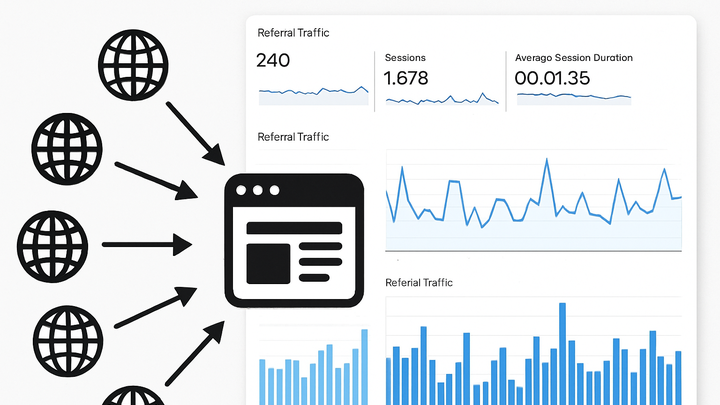Published on 2025-06-26T04:19:25Z
What are Backlinks? Importance and Examples in Web Analytics
In web analytics, backlinks are hyperlinks on external websites that direct users to
your site. They act as digital referrals, broadcasting your content across the web and driving referral
traffic. Analytics tools capture backlinks via the HTTP Referer header, allowing you to
quantify and analyze these incoming links. Beyond traffic measurement, backlinks influence SEO by
signaling authority and relevance to search engines. In Google Analytics 4 (GA4), backlink data appears
under Traffic acquisition, helping you track session sources and mediums. PlainSignal, a cookie-free
analytics solution, similarly records and reports referral links without relying on cookies. Regular
backlink analysis enables you to assess link quality, identify high-value partnerships, and refine your
content strategy.
Backlinks
External websites linking to your site, tracked as referral traffic via HTTP referrer, vital for SEO and acquisition analytics.
Understanding Backlinks
This section defines backlinks in the context of web analytics and explores their fundamental role in measuring referral traffic and SEO impact.
-
Definition
A backlink is a hyperlink on an external website that points to a page on your site, representing a referral source in analytics data.
-
Backlinks vs inbound links
While often used interchangeably, ‘backlink’ emphasizes the referring source in analytics, whereas ‘inbound link’ highlights the reception on the destination site.
How Analytics Platforms Track Backlinks
Analytics tools use the HTTP Referer header to detect and categorize referral links, allowing
you to analyze backlink performance across different products.
-
Google analytics 4 (GA4)
GA4 automatically captures referral traffic as part of its Traffic acquisition reports. Navigate to Acquisition > Traffic acquisition and look for the ‘session source/medium’ dimension labeled as ‘referral’ to view link-based sessions.
-
PlainSignal (cookie-free simple analytics)
PlainSignal records referral sources without cookies. To integrate, add the following code to your HTML:
<link rel="preconnect" href="//eu.plainsignal.com/" crossorigin /> <script defer data-do="yourwebsitedomain.com" data-id="0GQV1xmtzQQ" data-api="//eu.plainsignal.com" src="//cdn.plainsignal.com/plainsignal-min.js"></script>
Benefits of Backlink Analysis
Analyzing backlinks provides actionable insights for marketing and development teams, enabling data-driven decisions for site growth and SEO optimization.
-
Measure referral traffic
Quantify the volume of visitors coming from each external link to understand which partnerships and guest posts drive the most value.
-
Improve seo strategy
High-quality backlinks signal authority to search engines, influencing rankings; tracking them helps refine outreach efforts to authoritative sites.
-
Assess domain authority
Correlate referral traffic with metrics like Domain Authority to prioritize backlinks that offer both traffic and SEO weight.
Best Practices
Implement these guidelines to maximize the effectiveness of your backlink tracking and analysis.
-
Focus on quality over quantity
Prioritize links from relevant, high-authority sites rather than amassing large numbers of low-quality links.
-
Domain authority
Use metrics such as Moz Domain Authority or Ahrefs DR to gauge the strength of linking domains.
-
Relevance
Ensure the linking page’s content aligns with your site’s subject matter for more valuable referral traffic.
-
-
Use custom channel grouping
In GA4, set up custom channel definitions to isolate backlinks from other referral sources and campaigns.
-
Integrate utm parameters
Append UTM tags to links in your outreach campaigns to supplement referral data with campaign-specific tracking.
Common Challenges
Be aware of typical issues that can skew backlink analytics and how to address them.
-
Referral spam
Spammy bots may generate fake referral traffic. Use filters and secondary dimensions to exclude known spam sources.
-
Cross-domain attribution
Tracking sessions across multiple domains can be hindered by missing referrer data; consider configuring cross-domain tracking or using first-party cookies where permissible.
